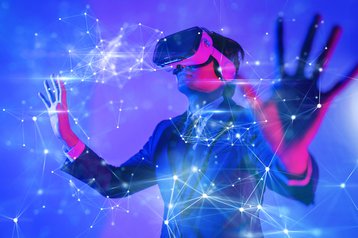One of the biggest challenges for the data center industry is staffing. Jobs in the industry require a specific set of skills, and as the need for more facilities continues to grow at an exponential rate, bolstered by the rise of new developments such as the much hyped Metaverse, the need for more skilled staff to design, build and run them grows too, and that creates significant challenges.
With a recent report showing an acceleration in the long term decline in students studying STEM subjects, that challenge isn’t getting any easier. DCD spoke to Pankaj Sharma, global executive vice president of Schneider Electric’s Secure Power Division about how the data center industry can address the skills shortage.
To start, let’s break the problem down. Sharma explains exactly why we are in a data center skills shortage that will only continue to grow if the industry doesn’t do its part to encourage uptake:
“Let’s take as a baseline that it requires around 300 people to build and operate a data center. It needs people to design and build those data centers, write the software that runs them, and operate them day-to-day. The reason that’s an important conversation today is because the rate at which the growth of data centers is going to happen, or is already happening is very different from what it has been in the last few years. From a staffing point of view, that’s 300x an exponentially growing number of facilities.”
Sharma goes on to explain the types of skills that are needed. It’s important to recognize that there’s an overlap in transferable skills between different aspects of data center build and operation.
“When you think of data centers, you have three parts – you have the compute part, you have the networking part, and you have the physical infrastructure. The skills needed in all these three areas stem from physical infrastructure, so power and electronics as a base. Then there’s digital, which is a lot around software development. When you think about compute, again, it's a mix of power, electronics, AI, software development, and so on.
But how does that knowledge affect the way that Schneider is going about tackling the problem?
“We work to build the physical infrastructure and software linked to physical infrastructure, so the skills which we need are people who are able to think about how to build the tools from an AI perspective, do the software development around us, do power electronics, and create basic physical infrastructure products, whether its UPS is its switch carriers, and all of those other types of infrastructure products.”
One challenge is that the emphasis in schools tends to be on software development, and as such, there’s a steady stream of budding software developers, but the hardware side, though vital, tends to get overlooked. It’s a common conversation for Sharma during his outreach works.
“When I go and meet students at universities, I'm trying to remind everybody that you could do the best software development, AI, and all of those other pieces which are required today, but all that has to sit on a physical infrastructure, so you need to be able to design the physical infrastructure first. Hence the need for power electronics, and hence the need for ideas on the hardware.”
But that’s not to devalue the importance of the software side – this is where there’s not only a wide variety of skill sets required, but skills that are transferable between aspects of the data center process:
“If you're a software developer, you could do the compute software development, plus you could also do software development for the hardware. That's where transferability comes into play. Similarly, when you're thinking of AI as an example, from the perspective of the number of instances you're looking at and how that turns into a certain predictability or a messaging, that can be both on hardware and software.”
We’ve talked about that hardware/software divide, but is there an inherent problem with the way STEM subjects are taught? And if so, does that present a huge roadblock in the recruitment process? In short, can companies like Schneider look outside STEM programs to bolster their talent pool, with self-taught or hobbyist electricians and coders?
“STEM programs are a very important foundation for AI, software development, hardware, power, electronics, electrical engineering, etc. I think those skills and that time spent in an undergraduate program are absolutely crucial. Now, could somebody do an AR type of work without going to an undergrad institute? I don't know, it's very hard for me to say, I think those programs or those education programs are absolutely crucial to build the base on which then you can actually do more work.”
Another consideration is that, however crucial data centers are in terms of running the services, streaming the videos and facilitating the chats we have every day, they’re not the glamorous front-end. That’s why it’s important for large companies, including Schneider, to offer students and anyone interested in a career in IT the chance to make the connection between the “cool stuff” they consume, and the infrastructure they could be a part of to make it all happen.
With the Metaverse being a favorite subject, which itself could have such an impact on data center usage, it’s a great way to forge that connection. Along the way, hot-button issues for young people, such as sustainability can be brought in to show how a career in data centers can be just as cool.
“Because of the direct linkage between the potential impact of Metaverse to the planet – that’s to say you need to build more data centers, it's not good for the planet, so how you can build better data centers, more efficient data centers, and the direct link between what we talk about as sustainability and the planet. When I'm discussing with students in different parts of the world, it really resonates with them.”
For Sharma, it comes down to changing the way businesses mentor potential employees, going beyond explaining what the job entails, to looking at what that person wants to achieve from a holistic standpoint.
“Mentorship has to go beyond just things like leadership, to thinking about the purpose, your personal purpose, your career, and so on. Once you're able to make that connection, then people, especially the younger generation think ‘Yeah, this makes sense. If I am an NBA fan, and I love to watch games on the metaverse, and all that compute happens in a data center, if I get an opportunity to go build that data center, or contribute to the building of that data center, I'd love to do a job like that.’ It’s an important aspect for all of us as leaders to start to apply beyond the basics of mentorship around leadership, people management and so on.”
And people respond to that?
“You'll be surprised at the level of response you get from the students who are either in STEM or are thinking about STEM. The amount of feedback you get from these students, it's just amazing. I think if we were to consistently do that, as leaders in the industry, I think it's an easy connection to make.”
Another challenge facing recruiters is the changing face of work in the post Covid-19 world. Gone are the days of 40 hours, Monday to Friday in an office or on a site. Young people have expectations around flexible working and freelance or “gig” opportunities that give them better quality of life balance.
Sharma explains that one of the best ways to deal with that change in mindset is to embrace it.
“I think the starting point is acceptance of new ways of working. A lot of us are starting to think about the general purpose of what we are trying to achieve as a human being. Do we really want to just
spend all our time just working like crazy or do we want to work at our own pace?
“People are now thinking, ‘if I can work at my own pace, and still do what I want from a career, passion and purpose point of view, that's the best situation’. What it means then is even in skills like AI or power electronics, if we, as large companies, are able to accept as people who will work for us for maybe a day a week or three days a week or a couple of hours a day, then it's easier for us to attract more and more talent."
However, while that can help relieve some aspects of the shortfall, it’s not the solution, because the needs of the business can’t always live up to the new paradigms of work.
“You have to break out your kind of work into a gig, in a non-gig type of format. If you're designing a complete ecosystem of products, you can take pieces of those designs and have contributions towards them from skilled workers in a gig mode, but you cannot have the whole ecosystem design built like that. That means, if you're building the whole ecosystem design, only small pieces can be outsourced into the gig economy. For large companies, including Schneider Electric, I would say, we have to accept that gigs are the new way of work, but it's not the only new way of work.”
The underlying secret then, is that to change mindsets towards channeling their skills into data centers, companies have to change their mindset too, and look at what people want from a career, and how the industry can change to accommodate those ambitions – be they “cool” stuff like streaming content and video games, or “hot button issues” like the environment. Sharma finishes by summing up how Schneider is making that change and how other businesses can too.
“As a company, we explain to these students, from a Schneider standpoint, or from a power electronics perspective, how you can contribute to creating something which will be very linked to renewable energy, and how you can help sustain the planet better. We help make those kinds of connections.
“I feel that the data center industry is probably going to be one of the most important pieces of the overall digital economy puzzle, because this whole digitization, whether it's e-commerce, whether it's the metaverse or the NBA example, or fashion shows in metaverse, medical sciences – all of that is possible only if you're able to build more and more data centers, so the data center industry is one of the most important pieces of this whole digital economy enablement.”
More on skills and workforce
-

Understanding Africa's data center challenge
As investors finally build data centers for Africa’s emerging technical generation, will the continent get the infrastructure it needs?
-

Sponsored Bridging the skills shortage
Why a diverse and resilient workforce is essential for the data centers of the future
-

DCD>London: Google's Heather Dooley uses detail to take on recruitment diversity
You can't have a pipeline of new talent unless they know you are there, and you speak their language



